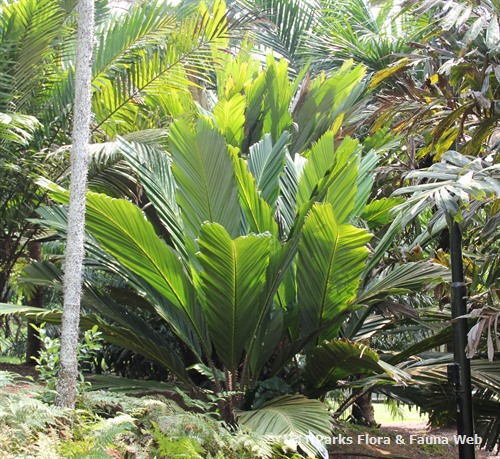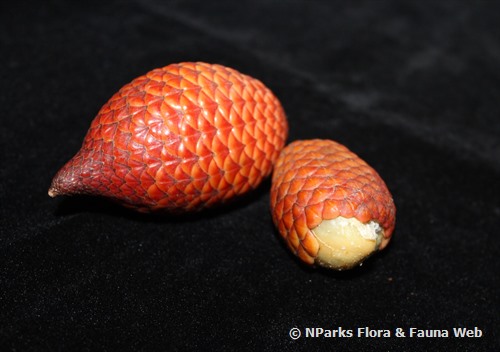
Name
Classifications and Characteristics
| Plant Division | Angiosperms (Flowering Seed Plants) |
|---|---|
| Plant Growth Form | Palm (Clustered Habit) |
| Mode of Nutrition | Autotrophic |
| Maximum Height | 3 m |
Biogeography
| Native Distribution | Peninsular Malaysia, Singapore, to Sumatra, and Borneo |
|---|---|
| Native Habitat | Terrestrial (Primary Rainforest) |
| Preferred Climate Zone | Tropical |
| Local Conservation Status | Native to Singapore (Critically Endangered (CR)) |
Description and Ethnobotany
| Growth Form | It is a clustering, understorey palm, up to 3 m tall. The stems are short and stout, and occasionally appear stemless. Its numerous large, pinnate leaves are arranged in a dense rosette. |
|---|---|
| Foliage | Its spirally arranged, stalked, spreading leaves are 3–4 m long, pinnate with oblong leaflets in clusters, and evenly spaced in a single plane on each side of the rachis. The leaflets are about 30–40 cm long, green, oblong, with curving sides, and a pointed tip. The back of the rachis is covered with long spines. |
| Flowers | Its inflorescences are erect, with male flower spikes about 2.5–6.4 cm, borne solitarily or in groups of 2–3, are thinly wooly, and subtended by a 10–18 cm long spathe (modified leaf). The female inflorescences are branched, 5–8 cm long, bearing small, scattered, alternate short spikes with about 3 flowers each. |
| Fruit | Its reddish-brown fruits are scaly, smooth and round, tapering at the tip and base, and about 2.5 cm in diameter. |
| Etymology | Malay salak, the vernacular name for Salacca zalacca, a commonly consumed palm fruit; Latin affinis, related or similar to, probably referring to the plant’s similarity to Salacca zalacca. |
| Ethnobotanical Uses | Edible Plant Parts : Edible Fruits |
Landscaping Features
| Landscaping | It may be suitable for parks but the spiny leaves must be noted, so where it is planted must take this danger into account. |
|---|---|
| Desirable Plant Features | Ornamental Form |
| Landscape Uses | Parks & Gardens |
Fauna, Pollination and Dispersal
| Pollination Method(s) | Biotic (Fauna) |
|---|
Plant Care and Propagation
| Light Preference | Semi-Shade |
|---|---|
| Water Preference | Lots of Water |
| Plant Growth Rate | Moderate |
Foliar
| Mature Foliage Colour(s) | Green |
|---|---|
| Foliar Shape(s) | Palm Fronds |
Non - Foliar and Storage
| Trunk Type (Palm) | Clustering Habit |
|---|
Fruit, Seed and Spore
| Mature Fruit Colour(s) | Brown, Red |
|---|
Image Repository
Others
| Master ID | 32883 |
|---|---|
| Species ID | 7297 |
| Flora Disclaimer | The information in this website has been compiled from reliable sources, such as reference works on medicinal plants. It is not a substitute for medical advice or treatment and NParks does not purport to provide any medical advice. Readers should always consult his/her physician before using or consuming a plant for medicinal purposes. |

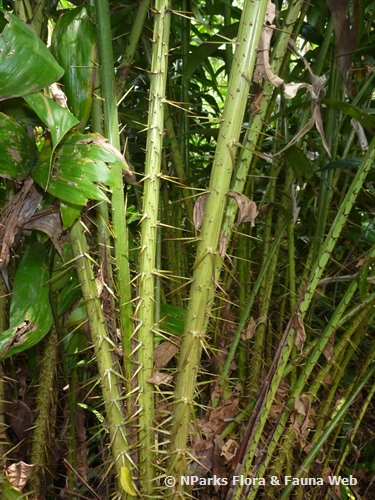
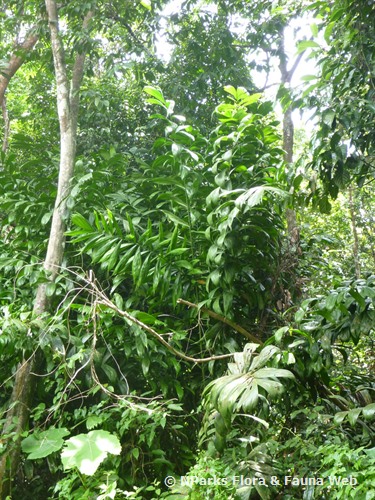
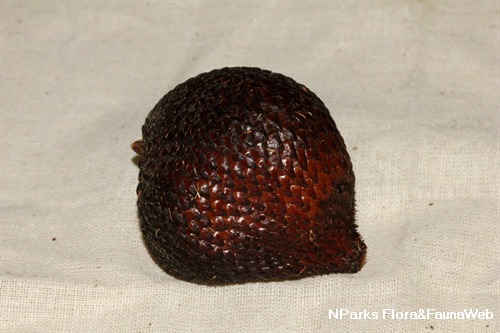
_lowres.jpg)
